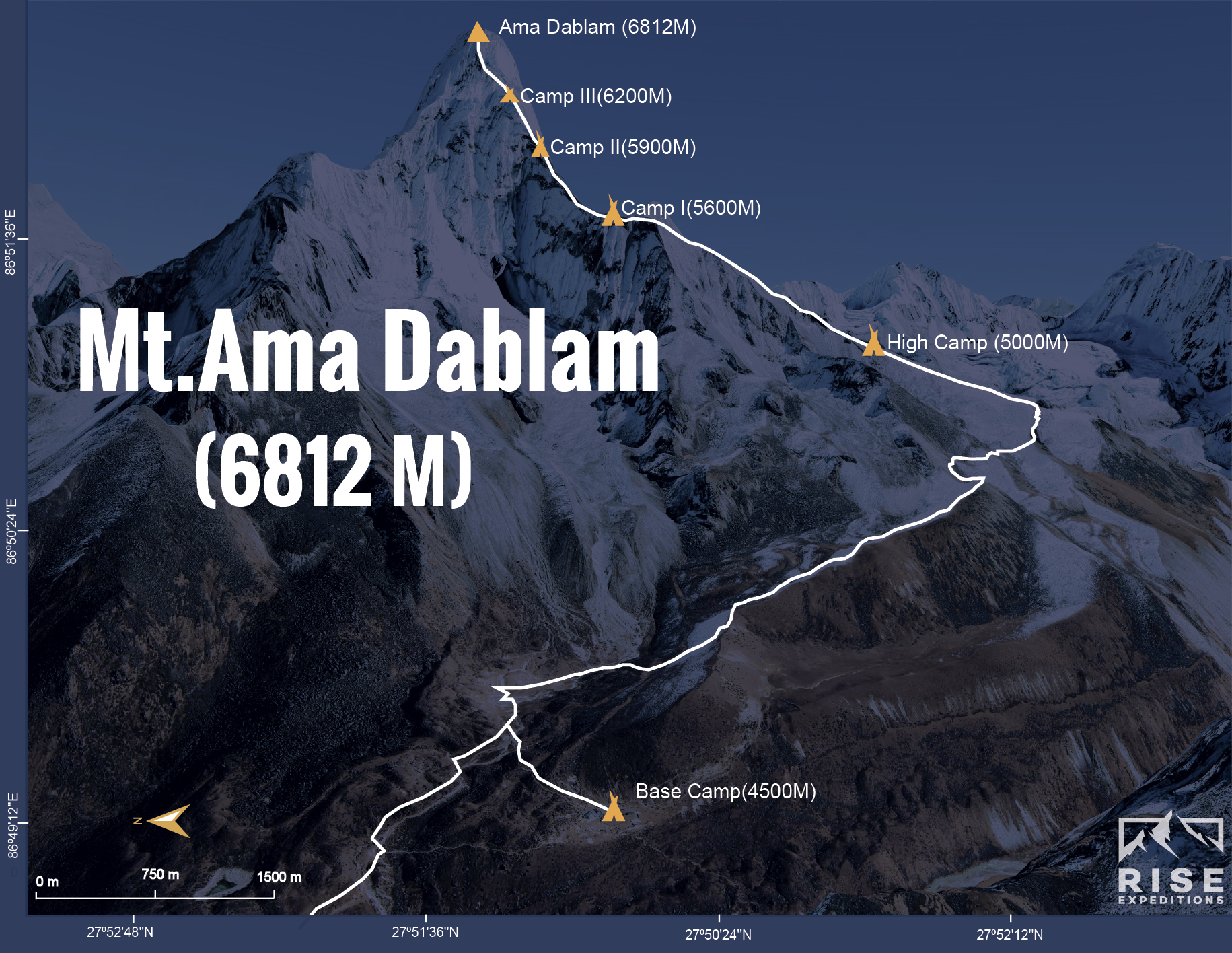Ama Dablam is a magnificent peak in Nepal’s Khumbu region, specifically in the Solukhumbu district. It stands at an amazing elevation of 6,812 meters above sea level and is often referred to as a 7000-meter peak due to its technical difficulties. From its amazing altitude, Ama Dablam offers stunning views of the surrounding Himalayan peaks, including the world’s highest summit, Mount Everest, and the fourth-highest, Mount Lhotse.
In the Sherpa language, Ama Dablam is also known as “Mother’s Necklace,” where “Ama” means mother, and “Dablam” means necklace. This name reflects the mountain’s appearance like a protective mother with a snowy necklace around her.
A team of four climbers, Mike Gill, Barry Bishop, Mike Ward, and Wally Romanes, made the first successful ascent of Ama Dablam via the Southwest Ridge on March 13, 1961. This is now the normal route for most climbers attempting to summit Ama Dablam. Summiting Ama Dablam in the winter season is regarded to be extraordinarily difficult and rare due to harsh weather conditions, extreme cold, unpredictable climatic changes, and high winds. However, on December 5, 1983, three South Korean mountaineers, Nam Sun-Woo, Lim Byung-Kil, and Kim Young-Soo, used the standard southwest ridge route to reach the summit of Ama Dablam.
Mountain Facts
Trip Facts
Climbing History of Ama Dablam
1961- Ama Dablam was successfully climbed by a team of four climbers led by Mike Gill, Barry Bishop, Mike Ward, and Wally Romanes via the Southwest Ridge
1981- Reinhold Messner, a renowned mountaineer, made a solo ascent
1983- Three South Korean mountaineers, Nam Sun-Woo, Lim Byung-Kil, and Kim Young-Soo, made the first winter ascent via the traditional southwest ridge.
2001- A Japanese team made the first ascent of Ama Dablam’s challenging North Ridge

Upon your arrival at Tribhuvan International Airport, our representative will be there to welcome you. Our representatives will help you with your luggage and transfer you to your hotel. Once you reach the hotel, your rooms will be allocated and you can take rest at your rooms.
You’ll spend the next days preparing for your adventure. You’ll meet with your guide to obtain essential expedition information and permits. You may also visit Kathmandu’s attractions such as Swayambhunath Stupa, Boudhanath Stupa, Pashupatinath Temple, and Kathmandu Durbar Square.
Today, you’ll take an exciting and thrilling 30-35 minute flight from Kathmandu to Lukla, with breathtaking mountain views. After a short break in Lukla, you’ll begin your trek. You’ll go through picturesque Sherpa settlements and along the DudhKoshi River. You’ll arrive at Phakding after around 3 hours of trekking, where you’ll spend your first night in the Everest region.
Your trek continues along the Dudh Koshi River, passing under multiple suspension bridges, including the well-known Hillary Bridge. After around three hours of hiking, you’ll arrive at Monjo, the Sagarmatha National Park’s entrance. We’ll take a break here to check permits. Then you’ll head to Namche Bazaar, taking in the breathtaking scenery of the surrounding mountains and sherpa towns along the route. After around 5 to 6 hours, you will arrive in Namche Bazaar, popularly known as the “Gateway to the Khumbu.
Today is a rest day in Namche Bazaar to allow your body to acclimatize to a higher altitude. You can stroll around the bustling streets, visit the Sherpa Cultural Museum, or take a short acclimatization hike to Hotel Everest View, which offers panoramic views of Mt. Everest, Ama Dablam, and Lhotse.
After breakfast in Namche, you’ll head towards Tengboche passing through the beautiful Rhododendron forests. Along the way, you’ll get amazing views of Everest, Lhotse, Nuptse, and Ama Dablam. After a full day of hiking, you’ll arrive in Tengboche, famous for its Monastery and beautiful views of Mt. Lhotse and Ama Dablam itself.
Leaving Tengboche, you’ll head towards Ama Dablam Base Camp. The trail gradually lowers to Debuche and then ascends through lush forests, passing the Pangboche village along the way. After 5-6 hours of trekking, you’ll arrive at the base of the Ama Dablam, which is located at an elevation of 4,600 meters.
You’ll rotate to higher camps of Ama Dablam to acclimatize and prepare for the summit push during this period. Your summit day will be determined according to the weather reports.
On Day 26, you’ll leave Ama Dablam Base Camp and descend towards Namche Bazaar. After a day of hiking, you’ll reach Namche Bazaar, a bustling Sherpa town. You can stroll around Namche Bazar in the evening, Namche is one of the most happening settlements in Khumbu region. You can enjoy cafes, coffee shops, pubs and many more while in Namche.
Today, you’ll leave Namche Bazaar and descend towards Lukla, where your adventure began. After a long day of trekking (about 7-8 hours), you’ll arrive in Lukla, bringing your wonderful Ama Dablam adventure to an end.
Today, you’ll bid farewell to the Everest region and fly back to Kathmandu. When you arrive in Kathmandu, you’ll be transferred to your hotel for some most needed rest.
Today, you’ll have a leisure day in Kathmandu. You’ll have an opportunity to visit Kathmandu’s World Heritage Sites like Pashupatinath Temple, Boudhanath Stupa, Swayambhunath, and Kathmandu Durbar Square, buy souvenirs for your family and friends, or simply relax at your hotel. We will have farewell dinner at an authentic nepali restaurant with live cultural shows.
It’s time to say your final goodbyes to Kathmandu.
A representative from our company will meet you at your hotel and assist you with your international departure.
Rise Expeditions suggests the following list of gear and equipment to have for the Mt. Ama Dablam expedition:
Climbing Gear
Headwear
Bodywear (Clothing/Layering)
Handwear
Footwear
Personal Kit
First Aid Kit
Miscellaneous
